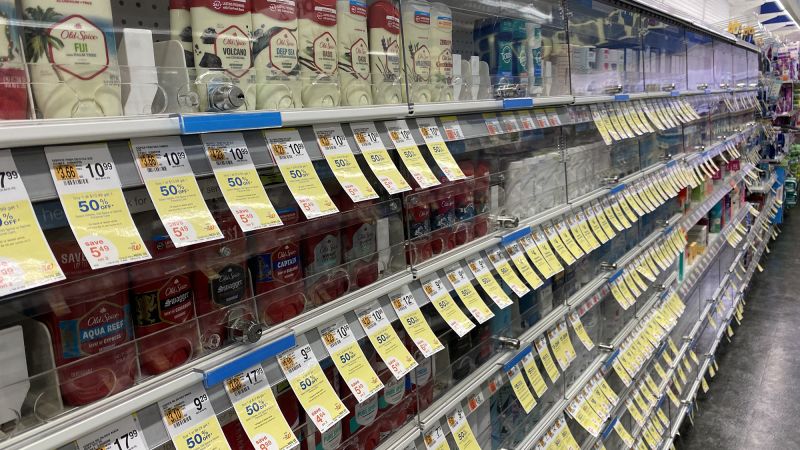Deodorant, detergent, granola bars, cookies, underwear. Shop for any of these every day items and you’ll scan not one but at least two, sometimes three different prices crammed underneath them on the store shelf.
Typically, one price label will say “Unit price.” That will be next to another label for the same product that says “You Pay,” or the actual price a shopper will pay at checkout. And then on deal days, a third price label often in a bright neon color, gets affixed next to or on top of the other two, bearing bold large numbers that are higher than the first but less than the second.
And for some specific purchases, such as cars, electronics and luxury items, there is yet another price indicator that’s dangled in front of shoppers. It’s called the “manufacturer’s suggested retail price” or MSRP.
Because product pricing is fluid, it makes it difficult to consolidate all these various prices on just one tag. Typically the “regular price” and the MSRP price stay constant the longest, but as discounts roll out, it forces stores to slap on the new price tags accordingly.
But are all of these price tags relevant or even beneficial to shoppers? It depends, according to industry experts.
“For a retailer, they’re primarily a tool to incentivize people to make a purchase,” said Laura Hensen, executive director of the Kohl’s Center for Retailing at the University of Wisconsin-Madison.
But there can be advantageous for consumers, too.
The unit price is the price per volume or weight of the item. So a product that comes in different sized packages will show a different unit price for each variety of package. Showing the price per unit of a product, whether it is a for a grocery item or a household product like detergent, is useful because it allows people to do a quick comparison, especially when the product comes in different sizes so that they get the best bang for their buck.
“If you think about a big jug of orange juice versus a smaller jug of juice, it might have a unit price value on that bigger one that shows big equals better deal,” said John Talbott, director of the Center for Education and Research in Retail at Indiana University Kelley School of Business. “That’s usually about retailers trying to get customers to understand that there’s value in buying in bulk.”
It’s still important to not assume that the bigger-sized option is the better bargain. Checking the unit price for each option will provide that clarity for shoppers.
Elsewhere, off-price discounters such as TJ Maxx tack on a price tag that shows the price the customer will pay at checkout, along with another, seemingly spurious “compare at” price on it.
“The ‘compare at’ language is used to imply that that price is what a customer would have paid had they purchased that item from another retailer,” said Mark Cohen, director of retail studies and an adjunct professor at Columbia University’s business school.
“This is somewhat murky because it can be challenged if that item was actually selling for that higher price somewhere else,” said Cohen, who was previous CEO of Sears Canada. To Cohen’s point, TJ Maxx has landed in trouble with customers who’ve challenged its “compare at” prices as being deceptive.
Think about the manufacturer’s suggested retail price, or MSRP, as just that. It’s a suggestion from the product maker about how much a customer should pay for it.
Talbott also calls it something else: “It’s a relic of the past,” he said.
Talbott explained that the practice of still displaying the MSRP alongside the retailer’s price for a product has historical roots in times when manufacturers had more influence over retail pricing.
“However, today it’s more of a marketing strategy than a legal requirement indicating that the retailer is giving a better price than what the manufacturer has suggested,” he said.
It’s history dates back to when Congress passed the first antitrust law, the Sherman Act, in 1890. It then passed two additional antitrust laws: the Federal Trade Commission Act (which created the Federal Trade Commission) and the Clayton Act, which prohibited price discrimination in dealings between suppliers and merchants.
According to the FTC, consumers should be aware that the key word in the MSRP is “suggested.” A merchant, it said, is free to set the retail price of products it sells. It can set the price at the MSRP or at a different price, as long as the retailer makes that decision independently.
At the same time, a manufacturer can also decide not to use distributors and sellers of its products that don’t abide by its MSRP.
“Retailers are free to set their own prices and offer discounts as they see fit as long as they comply with laws regarding truthful advertising and do not engage in anti-competitive practices,” said Talbott.

The MSRP continues to appear on handbags, coats, electronics and is commonly used in automobile sales. But how relevant is it today?
“You have to remember that manufacturers used to have a lot more power in the manufacturer-retail relationship,” he said. “Retailers used to be relatively small and privately owned. Its only been since the 1960s and 70s that we’ve seen consolidation into these huge entities where Walmart dictates terms to all of the people that supply it.”
Prior to that, he said manufacturers wielded the power. “They would say, unless you price our product at this price, we are not selling to you. They used it as a mechanism to discriminate against distributors who didn’t fall in line with their pricing policies.”
“I really think that the MSRP is just a legacy outcome from a law that was passed a long time ago. I don’t think its that useful to consumers now,” Talbott said. “It’s one of those legacy terminologies in the industry that just live on because that’s the way it’s always been.”
Read the full article here




